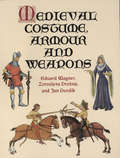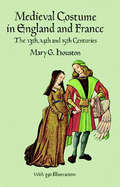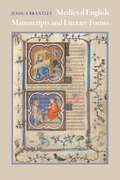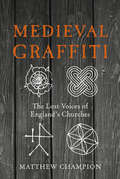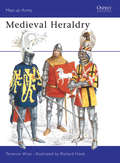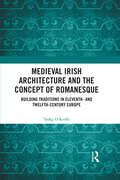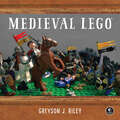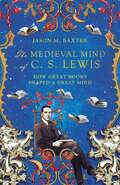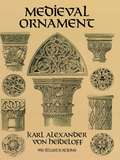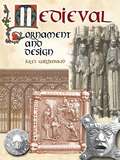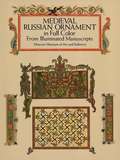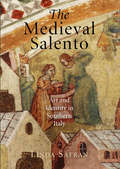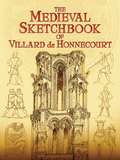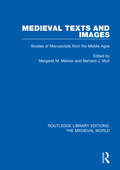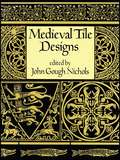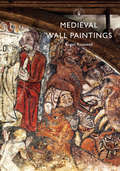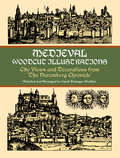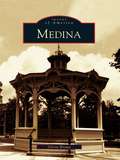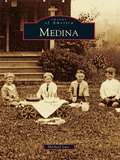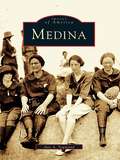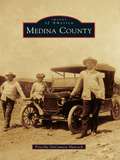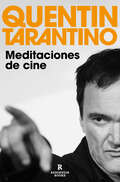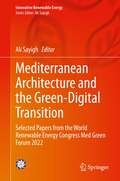- Table View
- List View
Medieval Costume, Armour and Weapons (Dover Fashion and Costumes)
by Zoroslava Drobná Eduard Wagner Jan DurdíkAccompanied by a scrupulously researched and well-documented text, over 400 royalty-free illustrations trace the evolution of clothing styles, armor, and weapons during the medieval period in Central Europe -- from simple tunics and robes of peasants to the battle equipment and armor of warriors and the fur-lined cloaks and brocaded garments of the aristocracy.
Medieval Costume in England and France: The 13th, 14th and 15th Centuries (Dover Pictorial Archive Ser.)
by Mary G. HoustonThis carefully researched volume offers lovers of both costume and the medieval period a meticulously researched and accurately detailed study of the clothing of the Middle Ages. Following an illuminating discussion of the style and construction of costumes worn in the thirteenth, fourteenth, and fifteenth centuries, noted costume historian Mary G. Houston provides detailed descriptions and illustrations of actual apparel worn by all classes and sectors of society. Included are elaborate royal, academic, and legal costumes; Eucharistic vestments and garments of religious orders; working class apparel; civilian dress; and more. Also examined is a wide variety of accessories and ornaments, jewelry, armor, textiles, embroidery, coiffures, and other items.The clear, succinct text is splendidly documented by 350 black-and-white line illustrations based on contemporary books and manuscripts as well as representations in paintings and sculpture. Indispensable for students of costume history, medievalists, illustrators, and fashion historians, Medieval Costume in England and France will delight anyone interested in the medieval period and its dress.
Medieval English Manuscripts and Literary Forms (Material Texts)
by Jessica BrantleyIn Medieval English Manuscripts and Literary Forms, Jessica Brantley offers an innovative introduction to manuscript culture that uses the artifacts themselves to open some of the most vital theoretical questions in medieval literary studies. With nearly 200 illustrations, many of them in color, the book offers both a broad survey of the physical forms and cultural histories of manuscripts and a dozen case studies of particularly significant literary witnesses, including the Beowulf manuscript, the St. Albans Psalter, the Ellesmere manuscript of the Canterbury Tales, and The Book of Margery Kempe. Practical discussions of parchment, scripts, decoration, illustration, and bindings mix with consideration of such conceptual categories as ownership, authorship, language, miscellaneity, geography, writing, editing, mediation, illustration, and performance—as well as of the status of the literary itself.Each case study includes an essay orienting the reader to particularly productive categories of analysis and a selected bibliography for further research. Because a high-quality digital surrogate exists for each of the selected manuscripts, fully and freely available online, readers can gain access to the artifacts in their entirety, enabling further individual exploration and facilitating the book’s classroom use. Medieval English Manuscripts and Literary Forms aims to inspire a broad group of readers with some of the excitement of literary manuscript studies in the twenty-first century. The interpretative frameworks surrounding each object will assist everyone in thinking through the implications of manuscript culture more generally, not only for the deeper study of the literature of the Middle Ages, but also for a better understanding of book cultures of any era, including our own.
Medieval Graffiti: The Lost Voices of England's Churches
by Matthew ChampionA fascinating guide to decoding the secret language of the churches of England through the medieval carved markings and personal etchings found on our church walls from archaeologist Matthew Champion.'Rare, lovely glimmers of everyday life in the Middle Ages.' -- The Sunday Times'A fascinating and enjoyable read' -- ***** Reader review'Superb' -- ***** Reader review'Riveting' -- ***** Reader review'Compelling, moving and fascinating' -- ***** Reader review*****************************************************************************************************Our churches are full of hidden messages from years gone by and for centuries these carved writings and artworks have lain largely unnoticed.Having launched a nationwide survey to gather the best examples, archaeologist Matthew Champion shines a spotlight on a forgotten world of ships, prayers for good fortune, satirical cartoons, charms, curses, windmills, word puzzles, architectural plans and heraldic designs.Here are strange medieval beasts, knights battling unseen dragons, ships sailing across lime-washed oceans and demons who stalk the walls. Latin prayers for the dead jostle with medieval curses, builders' accounts and slanderous comments concerning a long-dead archdeacon.Strange and complex geometric designs, created to ward off the 'evil eye' and thwart the works of the devil, share church pillars with the heraldic shields of England's medieval nobility.Giving a voice to the secret graffiti artists of Medieval times, this engaging, enthralling and - at times - eye-opening book, with a glossary of key terms and a county-by-county directory of key churches, will put this often overlooked period in a whole new light.
Medieval Heraldry
by Richard Hook Terence WiseCoats of arms were at first used only by kings and princes, then by their great nobles, but by the mid-13th century arms were being used extensively by the lesser nobility, knights and those who later came to be styled gentlemen. In some countries the use of arms spread even to merchants, townspeople and the peasantry. From the mundane to the fantastic, from simple geometric patterns to elaborate mythological beasts, this fascinating work by Terence Wise explores the origins and appearance of medieval heraldic devices in an engagingly readable style accompanied by numerous illustrations including eight full page colour plates by Richard Hook.
Medieval Irish Architecture and the Concept of Romanesque: Building Traditions in Eleventh- and Twelfth-Century Europe
by Tadhg O’KeeffeThis book presents a fresh perspective on eleventh- and twelfth-century Irish architecture, and a critical assessment of the value of describing it, and indeed contemporary European architecture in general, as “Romanesque”. Medieval Irish Architecture and the Concept of Romanesque is a new and original study of medieval architectural culture in Ireland. The book’s central premise is that the concept of a “Romanesque” style in eleventh- and twelfth-century architecture across Western Europe, including Ireland, is problematic, and that the analysis of building traditions of that period is not well served by the assumption that there was a common style. Detailed discussion of important buildings in Ireland, a place marginalised within the “Romanesque” model, reveals the Irish evidence to be intrinsically interesting to students of medieval European architecture, for it is evidence which illuminates how architectural traditions of the Middle Ages were shaped by balancing native and imported needs and aesthetics, often without reference to Romanitas. This book is for specialists and students in the fields of Romanesque, medieval archaeology, medieval architectural history, and medieval Irish studies.
Medieval Irish Architecture and the Concept of Romanesque: Building Traditions in Eleventh- and Twelfth-Century Europe
by Tadhg O’KeeffeThis book presents a fresh perspective on eleventh- and twelfth-century Irish architecture, and a critical assessment of the value of describing it, and indeed contemporary European architecture in general, as “Romanesque”.Medieval Irish Architecture and the Concept of Romanesque is a new and original study of medieval architectural culture in Ireland. The book’s central premise is that the concept of a “Romanesque” style in eleventh- and twelfth-century architecture across Western Europe, including Ireland, is problematic, and that the analysis of building traditions of that period is not well served by the assumption that there was a common style. Detailed discussion of important buildings in Ireland, a place marginalised within the “Romanesque” model, reveals the Irish evidence to be intrinsically interesting to students of medieval European architecture, for it is evidence which illuminates how architectural traditions of the Middle Ages were shaped by balancing native and imported needs and aesthetics, often without reference to Romanitas.This book is for specialists and students in the fields of Romanesque, medieval archaeology, medieval architectural history, and medieval Irish studies.
Medieval LEGO
by Greyson BeightsMedieval LEGO takes you through real English history in the middle ages with a unique twist, with every event illustrated by a tiny little LEGO scene. With contributions by medievalists and scholars, this book brings medieval history to life in a fun, kid-friendly way.Inside, you'll learn about events like the Battle of Hastings, the chartering of Oxford University, and the signing of the Magna Carta. You'll witness the infamous Black Death, and the Great Famine, and you'll read about famous historical figures like Robin Hood, Richard the Lionheart, Geoffrey Chaucer, and William the Conqueror.Grab your broadsword and turn the page to join the adventure.
The Medieval Mind of C. S. Lewis: How Great Books Shaped a Great Mind
by Jason M. BaxterC. S. Lewis had one of the great minds of the twentieth century.Mere ChristianityThe Problem of Pain
Medieval Ornament: 950 Illustrations (Dover Pictorial Archive)
by Karl Alexander HeideloffThe decorative arts of the Middle Ages -- richly ornate, filled with religious and mythic symbolism -- were especially remarkable for the complexities of their design and their inspired craftsmanship. This fascinating volume presents nearly 1,000 illustrations of medieval ornament, consisting mostly of architectural elements from German Romanesque and Gothic churches and other buildings.Originally compiled by the German architect, painter, and engraver Karl Alexander von Heldeloff (1788-1865) as a source of study and inspiration for practicing artists and architects, this grand pictorial archive has been exactingly reproduced from a rare original edition, complete with new English translations of the German captions.The book is filled with precisely detailed engravings of doors, windows, decorative stonework, columns, pedestals, and more. It remains a richly varied resource of authentic images of medieval ornament, ideal for students of architecture and the decorative arts and essential for graphic artists and designers in search of royalty-free illustrations.
Medieval Ornament and Design
by Jules GailhabaudThis lavish archive of exquisite engravings and designs--originally created in the mid-nineteenth century for the professional artist and architect--contains some 200 splendid illustrations, expertly adapted from decorative as well as utilitarian features of medieval cathedrals, churches, tombs, houses, shops, public buildings, and other structures. Encompassing a wide variety of styles, the designs include finely detailed panels, gawking gargoyles, marvelously carved pillars and pedestals, exquisite ironwork patterns, decorative stonework, magnificent stained glass windows, moldings enhanced with intricately woven motifs, and much more.Artists, designers, and craftworkers will find wide use for these versatile, royalty-free illustrations. Students of architecture, art historians, and lovers of ornamental art will delight in the pure beauty of this magnificent collection.
Medieval Russian Ornament in Full Color: From Illuminated Manuscripts (Dover Pictorial Archive)
by Moscow Museum of ArtThis beautiful book illustrates the splendid ornamental lettering and decorative art in illuminated Russian manuscripts dating from the 10th through the 16th centuries. It contains over 1,000 motifs reprinted in full color from a rare book of design first published in France in 1870. Among the designs are richly embellished letters from the Cyrillic and Greek alphabets, elaborate manuscript page heads and ornate corners and borders. Many of the designs incorporate mythological creatures, religious iconography, and design elements deeply rooted in early Slavic and Byzantine cultures. There is a strong Celtic flavor as well. On page after page, the distinctive motifs in this collection reflect the unique heritage of Russian design, a rich amalgam of East and West. Students of graphic design and the decorative arts will find the book an invaluable reference. Graphic artists will find these rare, copyright-free examples of medieval ornament, which lend themselves to color copying, ideal for many kinds of projects.
The Medieval Salento: Art and Identity in Southern Italy (The Middle Ages Series)
by Linda SafranLocated in the heel of the Italian boot, the Salento region was home to a diverse population between the ninth and fifteenth centuries. Inhabitants spoke Latin, Greek, and various vernaculars, and their houses of worship served sizable congregations of Jews as well as Roman-rite and Orthodox Christians. Yet the Salentines of this period laid claim to a definable local identity that transcended linguistic and religious boundaries. The evidence of their collective culture is embedded in the traces they left behind: wall paintings and inscriptions, graffiti, carved tombstone decorations, belt fittings from graves, and other artifacts reveal a wide range of religious, civic, and domestic practices that helped inhabitants construct and maintain personal, group, and regional identities.The Medieval Salento allows the reader to explore the visual and material culture of a people using a database of over three hundred texts and images, indexed by site. Linda Safran draws from art history, archaeology, anthropology, and ethnohistory to reconstruct medieval Salentine customs of naming, language, appearance, and status. She pays particular attention to Jewish and nonelite residents, whose lives in southern Italy have historically received little scholarly attention. This extraordinarily detailed visual analysis reveals how ethnic and religious identities can remain distinct even as they mingle to become a regional culture.
The Medieval Sketchbook of Villard de Honnecourt (Dover Fine Art, History Of Art Series)
by Villard De Honnecourt Theodore BowieLittle is known of Villard de Honnecourt, apart from the fact that his Sketchbook is one of the most treasured documents in art history. Active in the early part of the thirteenth century, the French artist produced remarkably accurate representations of diverse subjects that interested him: religious figures; insects, birds, dogs, and humans; architecture, including details from the cathedrals at Chartres, Rheims, and Laon; church furnishings; and mechanical devices. His technique--for the period--was fairly complex, especially when drawing the contours of draped clothing.The artist's charming, annotated sketches reveal a knowledge of architecture, sculpture, carpentry, and masonry; and his comments reflect a keen and perceptive eye, whether depicting a monumental clock tower or describing a perpetual motion machine. Comparable to da Vinci's notebooks for their historical importance, the drawings from Honnecourt's portfolio are reproduced here in their entirety, complete with authoritative translations of the artist's words, annotations, and editor's commentary.
Medieval Texts and Images: Studies of Manuscripts from the Middle Ages (Routledge Library Editions: The Medieval World #32)
by Margaret M. Manion Bernard J. MuirOriginally published in 1991, Medieval Texts and Images is a collection of essays which critically examines medieval manuscripts. The book contains a wide range of contributions, the first examines the relationship of the Légende Dorée and its relationship to the aristocratic patrons who commissioned these manuscripts; the second scrutinises the tradition of French illumination as it was developed in Paris in the so-called Bedford Master’s workshop in the 1420s. The text examines liturgical texts of the medieval period and written and liturgical contributions to Renaissance art. Other contributions include an investigation into the written scroll within the painted composition, comparing various compositional and thematic functions in the depiction of a Crucifixion and a study of Christian vernacular poetry. This collection provides a comprehensive overview of the use of text and image in medieval literature.
Medieval Theatre in Context: An Introduction
by John HarrisFirst Published in 1992. Routledge is an imprint of Taylor & Francis, an Informa company.
Medieval Tile Designs
by John Gough NicholsLittle remains of the decorative ceramic tiles that once paved the floors of medieval churches and cathedrals. Abraded by time and use, stolen by collectors, or covered by new flooring, these handsome ornamental paving stones (also known as "encaustic tiles") have become rarities. This practical, inexpensive, and comprehensive archive -- originally published in the mid-19th century -- has preserved many of those ancient designs for future generations. It represents an invaluable source of design inspiration for permission-free use by today's artists and craftspeople. Adapted largely from tile motifs that once adorned English churches in Winchester, St. Cross, Romsey, and Warblington, 146 handsome images display a host of characteristically medieval patterns -- crosses, churches, fleur-de-lis, stylized plant forms, mythological creatures, stars, abstract and geometric figures, and other authentic elements. These rich and evocative designs can be used to enhance a host of art and craft projects: wood burning, leathercraft, and stained glass work; fabric painting, ceramics, enameling, stenciling, or any other project calling for unique and powerful attention-getters.
Medieval Wall Paintings
by Roger RosewellWhat medieval wall paintings remain in English churches tend to be shadows of their former selves - rare fragments of art that have survived not only the Reformation, but successive waves of iconoclastic zeal and unsympathetic restoration. The whitewashed walls of most parish churches belie the riot of color and decoration that once adorned them, but the remnants of paintings tucked into corners or rescued from later layers of paint help us to understand the role of art in medieval religion. Roger Rosewell here offers a guide to the role played by medieval wall paintings, as religious, didactic and commemorative works of art, telling the stories of those who created them and those who used them on a daily basis. He also compares and contrasts religious and domestic wall paintings and uses beautiful color photography throughout to illustrate the story.
Medieval Woodcut Illustrations: City Views and Decorations from the Nuremberg Chronicle
by Carol Belanger GraftonPerhaps the most elaborately illustrated book of the 15th century, The Nuremberg Chronicle ranks with the Gutenberg Bible in terms of its magnificent craftsmanship and unsurpassed excellence of design. A rich selection of plates from this 1493 history of the world, long a treasured favorite of collectors, is now available in this inexpensive edition.This volume lovingly preserves the full grandeur of the original woodcuts, designed by the celebrated artists Michael Wolgemut and Wilheim Pleydenwurff. Some scholars believe that since Albrecht Dürer was Wolgemut's student at the time of the book's production, it is possible that he too contributed to the illustrations of the Chronicle. The plates shown here depict 91 locales as they appeared in 15th century Athens, Paris, Rome, Vienna, Jerusalem, Venice, Prague, Munich, Nuremberg, Florence, and many more. Included are 51 city views, 26 of them double-page spreads, each one exhibiting a new mastery of perspective -- as this book embodies a stage in the evolution of art from the naïve to its more conscious form. An additional 143 miscellaneous illustrations of figures and decorative objects round out this volume, all of whose cuts emanated from the celebrated printing presses of Anton Koberger.
Medina (Images of America)
by Gloria BrownIn 1945, Pathfinder magazine selected the village of Medina as a "shining example of small town living" and, with the film company RKO Pathe, produced a 15-minute movie about Medina called Home Town USA. The film focused on the Victorian square and on the nearby tree-shaded streets lined with century homes. But the film did not tell the dramatic story behind the picturesque facade. Medina was hewn out of the Ohio wilderness by Connecticut Yankees, many of them Revolutionary War veterans who brought with them a tradition of democracy and strong community spirit. In 1848, a fire devastated the public square. The citizens rallied, and it was quickly rebuilt. In 1870, another fire wiped out most of the business district. Over the next decade, the square once again rose from the ashes, and the result was a village center filled with handsome Eastlake Victorian-style buildings. That public square sits at the heart of the community whose history this book puts on display.
Medina
by Michael LuisMedina has long been recognized as the home to wealthy and influential members of Seattle's elite. Industry captains such as Clapp, Blethan, Gates, and Bezos have built estates along Medina's waterfront. Meanwhile, a diverse group of families with a variety of backgrounds have settled the uplands, creating a close-knit community. Farmers, including many of Japanese heritage, first settled the area in the late 1800s. Upon the arrival of the car ferry service to Seattle in 1913, Medina gradually evolved into a commuter suburb for the working class and wealthy alike. In 1940, the first Lake Washington floating bridge ushered in a new era, and with incorporation in 1955 and the opening of the Evergreen Point Bridge in 1963, Medina completed its transformation to a largely residential area. Despite its marvelous growth, Medina has successfully maintained its charm. A new generation of families arrived in the 1990s, filling classrooms and parks, and renewing Medina's original identity: close to the big city, but a world apart.
Medina (Images of America)
by Avis A. TownsendMedina traces the history of a community that came to life with the building of the Erie Canal. Located at a bend in the canal, halfway between Buffalo and Rochester, Medina became a regular stop for barge traffic. The famous Medina culvert--the only tunnel road that goes under the canal--is here, as are the falls and Medina sandstone, quarried and used not only in local buildings but also across the state and even at Buckingham Palace.
Medina County
by Priscilla Dacamara HancockMedina County was founded in 1848 by settlers from Europe and the eastern United States. At the time, Native Americans still lived on that land, which they called "Comancheria." Full of hope for a better life, settlers tamed an unfamiliar landscape that was filled with prickly pear cactus, rattlesnakes, coyotes, mountain lions, bison, armadillos, pecans, persimmons, and mustang grapes. The first settlements in Medina County were Castroville, Quihi, Vandenburg, and D'Hanis. New Fountain, New D'Hanis, LaCoste, Rio Medina, Hondo, and others were established later. The settlers worked hard growing cotton and grain and raising cattle, and they retained their old-world customs and religious faith in the face of many challenges. With the building of the Medina Dam, farming changed for the better, and new immigrants arrived to help establish schools and communities. Today the proximity to San Antonio allows people to work in the city while maintaining their homes, farms, and ranches in Medina County.
Meditaciones de cine
by Quentin TarantinoLlega el esperado y ansiado primer libro de no ficción de Quentin Tarantino. Su libro más personal: un viaje íntimo por sus películas favoritas, relatado con una voz inconfundible. Probablemente, Quentin Tarantino sea uno de los mayores cineastas de la historia, pero de lo que no hay atisbo de duda es de que estamos hablando del espectador que mejor puede contagiar su pasión entusiasta por las películas que ha visto. Ahora, por fin llega el libro con el que tantos años soñaron él y sus seguidores. En Meditaciones de cine, Tarantino analiza desde los puntos de vista más insólitos y con su particular conocimiento enciclopédico varias películas clave del cine norteamericano de los setenta, todas ellas vistas en su más tierna infancia (de las más violentas a las más tórridas), así como revisitadas compulsivamente. El resultado es una obra tan rigurosa y reflexiva como juguetona y entretenida. Meditaciones de cine es, a la vez, crítica cinematográfica, teoría del cine, reportaje literario y unas memorias formidables, a la altura de clásicos del género como los de Hitchcock y Truffaut o Luis Buñuel. La crítica ha dicho...«Lo que une todos los hilos y temas de este libro es una rotunda verdad autobiográfica: que Tarantino ha sido espectador antes de ser cineasta y lo seguirá siendo durante muchísimo tiempo. Por eso es imbatible».The New York Times «Un libro en que se mezclan memorias, disquisiciones, arrebatos, entrevistas, datos recónditos, reflexiones fortuitas sobre actores de cine y directores, comentarios mordaces y demás obsequios sobre el viejo arte de sentarse en un patio de butacas a observar con placer imágenes en movimiento».Rolling Stone «No cuesta imaginar un universo alternativo (pero mucho más pobre) en el que Tarantino sea crítico de cine en vez de cineasta ganador de dos Óscar. Se nota que conoce bien lo que le gusta y sabe enganchar al lector con suma facilidad [...]. Un libro divertidísimo».San Francisco Chronicle «A nadie puede sorprender que la crítica cinematográfica de Tarantino sea tan rotunda, inteligente y asombrosa como sus películas».The New York Times «Descocado y audaz [...]. Nutre y apasiona a partes iguales, rebosa de vida en el mejor de los sentidos. Se nota que a Tarantino nada le gusta más que ir hasta el fondo de las películas».The Guardian «Lo que aquí ofrece Tarantino son cartas de amor muy bien documentadas a sus películas favoritas, salidas de uno de los momentos históricos más ambiciosos de Hollywood. Un ensayo de altos vuelos escrito por un artista único».Kirkus (Reseña destacada) «Tarantino trae la marcha y la exuberancia de su experiencia cinematográfica, su arte para contar historias y su humor agudo, así como una mezcla impresionante de historias personales, historia cinematográfica y crítica cinematográfica. [...] Este libro nos ofrece las historias chisporroteantes que hubo tras la producción y muchas críticas especulativas y exigentes. [...] Una celebración divertida e imprescindible del cine».Booklist (Reseña destacada) «Un libro totalmente cautivador, tan repleto de ideas ágiles y desopilantes, de opiniones contundentes y de disecciones afiladas de personajes y épocas que parece ideado para suscitar las más fecundas discusiones».The New Yorker «El entusiasmo, la generosidad y el singular punto de vista de Tarantino refuerzan sus argumentos, e incluso cuando derriba a sus héroes, lo hace por amor... inteligente y obsesivo, Tarantino es muy divertido y difícil de superar».Publisher's Weekly
Mediterranean Architecture and the Green-Digital Transition: Selected Papers from the World Renewable Energy Congress Med Green Forum 2022 (Innovative Renewable Energy)
by Ali SayighThis book contains selected papers presented during the World Renewable Energy Network’s biannual World Med Green Forum (MGF). The 2022 MGF highlights the role of renewable energy applications in the sustainable building sector with a focus on the Mediterranean region as a foundation for a truly positive energy future. MGF is an open roundtable for an international community of researchers, practitioners, and experts to discuss the most innovative and promising sustainable building technologies. The papers presented explore the intersection between twin transitions in policies, programs, projects, and experimentation, with the digital domain innovating the green building sector towards more reliable and inclusive planning and design practices in order to collectively envision future buildings and cities.
